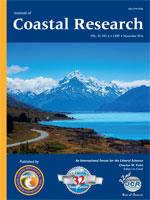Rangel-Buitrago, N.G.; Thomas, T.; Phillips, M.R.; Anfuso, G., and Williams, A.T., 2016. Wave climate, storminess, and northern hemisphere teleconnection patterns influences: The Outer Bristol Channel, South Wales, U.K.
This paper investigates potential climate-change impacts on the Outer Bristol Channel (Wales, U.K.) by analysing a 15-year wave-buoy dataset (1998–2013) to characterise wave climate and storms. The research showed that the increasing storminess experienced during the latter half of the 20th century did not, as expected, continue into the first decades of the 21st century; however, the wave climate showed clear cyclic variation in average monthly significant wave height (Hs), with low values occurring between May and August (Hs < 1.4 m, Hsmax < 6 m) and a minimum in August (Hs = 1.3 m, Hsmax = 5.2 m). Monthly mean wave power was 27.4 kwm−1, with a maximum of 951 kwm−1 during December. The 267 storm events were recorded during the assessment period. Storm-severity distribution presented a log-normal trend, with weak and moderate events making up 73% of the record (125 and 69 events, respectively); significant (18%), severe (4%), and extreme (6%) storms resulting in 73 events that are more destructive made up the remainder of the record. Fifty-five percent of the monthly averaged wave variations, wave power, and storminess indices are linked to several teleconnection patterns, the most relevant being the Arctic Oscillation, with 23.45%, the North Atlantic Oscillation, with 20.65%, and the East Atlantic with 10.9%. This kind of characterization is essential for design considerations to any proposed developments within the Bristol Channel that affect the coastal zone, e.g., the proposed design of the Swansea Bay Tidal Lagoon, which is capable of generating over 542,000 MWhyr−1 of renewable energy.





